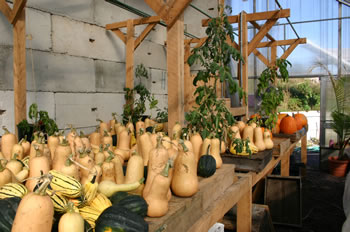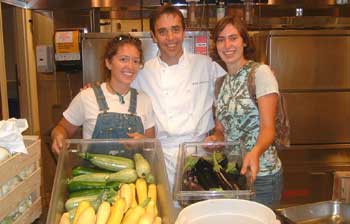
Farmelton
The Carleton Farm
A project of the Bio 160 Agroecology Course
The Farm-Dining Connection at Other Colleges Our group contacted several schools of a variety of sizes, with farms ranging from eighty-three to less than one acre, in the hopes of learning from others’ successes and failures in interfacing their farms with their school’s dining services. Of those, we received replies of any length from five schools:
|
 |
Small Plots
The first thing we noticed in all the responses was the small size of their farms. In our email exchange with the staff manager of Dickinson College farm, we realized why an eighty-three acre farm, such as at Berea College, is beyond the ability of the college and scope of the project. The Dickinson manager pointed out the need for a great deal of full-time farm work, which students cannot really provide unless it is built into their curriculum. Berea runs their farm as part of their agricultural studies program, which will not be an available resource for Carleton.
These constraints produced a number of common solutions for dealing with campus dining services and service providers. While most of the schools that responded at length to our inquiries had in-house dining services, we think their experiences and advice are still quite valid and relevant for Carleton students, staff, and faculty planning a campus farm. While the College administration might not poses quite the same leverage over the Sodexho team at Carleton, the needs of the dining halls – which of necessity must drive the farm project – are essentially the same.
The three schools that regularly provided their dining hall with produce agreed that a close relationship with the dining services manager and the head chefs at the dining halls was absolutely essential to any successful farm. Since each farm’s produce was such a small fraction of the dining hall’s total purchases, they stressed that without this close relationship it could easily be more convenient for the manager to fill their stocks from their usual producers. Representatives from the farms at Middlebury College, Green Mountain College, and Lawrence University all met with or communicated with the senior chefs and heads of purchasing at their respective food services “every few days” in order to take orders, and discuss what would be next available. Middlebury farmers said that they frequently could only give “a few days’” notice to chefs, and mentioned that last-minute menu changes were occasionally necessary if produce was not ripe on time.
| The farmers at Middlebury and Green Mountain Colleges said they based what they grew each year on what the dining halls needed, and staggered the plantings in order to provide produce over a longer period of time during the school year. Middlebury farmers recommended mezclun lettuce, baby spinach, golden beets, sugar snap peas, butternut squash, slicing tomatoes, cherry tomatoes, and swiss chard as crops that they could grow in sufficient quantities to be usable to the dining halls, and both schools said they made deliveries to the dining halls as frequently as they talked with chefs and managers, frequently the day after these meetings. They said that students picked, washed, packed, and delivered the crop themselves. |  |
All five schools, however, do not rely solely on their dining halls to for income, which generated a number of interesting and unusual ideas. The student-farmers at Lawrence University offered some of the most original, suggesting that we sell to local restaurants and grocery stores, and shared an idea they were looking into – “edible classroom” educational-outreach programs in the local community. Due to the size of UNH-Durham (10,000 students, they told us), the dining halls there have little need for their produce; however they do sell some produce to the school for special dining events. Dickinson College farmers said they used dining hall food waste as compost, a particularly intriguing idea since Carleton has recently implemented a large-scale composting program. All of these ideas we felt would be worth further study if more concrete planning on this farm goes forward.

Surprisingly, only one school, Green Mountain College, mentioned health code compliance as an issue. The other three explained that since they do no preparation, they are exempt from local health code regulations. Of course, this issue depends entirely on Minnesota’s and Northfield’s regulatory regimes, but it would seem likely that health regulations will not be an issue to a potential Carleton farm. What may emerge as a problem, however, is “organic” certification and regulations, and their impact on prices: of the five, only UNH is officially certified “organic”, the rest manage according to federal standards, but have not become certified. Presumably, there are cost issues related to the certification process, but it may be that the higher price that comes with an “organic” certification is not worth the trouble.
In addition to the small size of their harvests, the student farmers also had to concern themselves with their dining halls’ produce requirements. These were generally uniform among the schools, and cut to the heart of the relationship between these farms and their dining halls. Everyone spoke of a need for clean, “normal-looking” vegetables that were the same size and shape as those the chefs were used to working with – the conventional produce bought through a distributor. Freshness and timeliness, though, were paramount concerns for the three schools that sell produce to their respective dining services. Both the Middlebury and Green Mountain farms said it was an issue “(re)learning” what constitutes usable produce – a suggestion that any Carleton farm will need to develop some kind of institutional memory and quality-control teaching process, to make sure we would be properly meeting our main customer’s needs.
In all, the experience of these five farms serves provides some guidance and advice for future planning, particularly if a vegetable garden becomes the preferred option. As discussed above, a very close working relationship between the farm and the chefs and managers is at the heart of any farming endeavor. Above all else, this would be to ensure not only that the dining service provider will actually buy the produce, but also to make the relationship function smoothly -- figuring out the mundane details of a production schedule, orders for the next few days, and what to grow for each season. |
 |
Beyond this, however, it would seem that these other small student farms have a relatively uncomplicated relationship with their dining services. They have orders to fill; they pick and wash the produce, pack it, and deliver it themselves on a regular basis, several times a week. It does not seem that any particular complicated system of storage or transport is need – food comes from land to table almost directly. Lastly, these other schools’ experiences caution us to “think small.” A tremendous amount of land would be needed to grow for all of Carleton’s 1,800-plus students, plus faculty and staff, with an equally large number of student workers needed to actually work the land, both of which it would be hard to come by at Carleton without a significant investment of resources. In trying to supply the dining hall, any organic farm here would have its hands full with a modest goal like Green Mountain College’s farm to supply five percent of their dining halls’ total needs in the next five years.